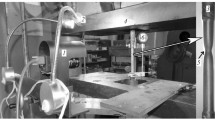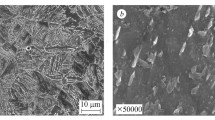We study the influence of the shape and sizes of defects on the strength of thermally hardened steel reinforcement and construct the stress-strain diagrams for reinforcements with different types of defects. For the first time, the method of binarization of images is used for the evaluation of the areas of fracture surfaces of samples with an aim to establish true critical stresses. It is shown that isolated sharp defects are more dangerous than a system of defects of this kind or long isolated corrosion defects. We also demonstrate the advantage of application of true stresses for the evaluation of strength of the reinforcement.





Similar content being viewed by others
References
GOST 1497-84. Metals. Methods of Tensile Testing [in Russian], Introduced 01.01.86.
R. J. Kosarevych, B. P. Rusyn, V. V. Korniy, and T. I. Kerod, “Image segmentation based on the evaluation of the tendency of image elements to form clusters with the help of point field characteristics,” Cybernet. Syst. Anal., 51, No. 5, 704–713 (2015).
R. Y. Kosarevych, O. Z. Student, L. M. Svirska, B. P. Rusyn, and H. M. Nykyforchyn, “Computer analysis of the characteristic elements of fractographic images,” Fiz.-Khim. Mekh. Mater., 48, No. 4, 53–60 (2012); English translation: Mater. Sci., 48, No. 4, 474–481 (2013).
S. Beucher and C. Lantuejoul, “Use of watersheds in contour detection,” in: International Workshop on Image Processing, Real-Time Edge and Motion Detection/Estimation, Rennes (1979), pp. 1–12.
R. Barnes, C. Lehman, and D. Mulla, “Priority-flood: an optimal depression-filling and watershed-labeling algorithm for digital elevation models,” Comput. Geosci., 62, 117–127 (2014).
H. Steinhaus, “Sur la division des corps materiels en parties,” Bull. Acad. Polon. Sci., 4, No. 12, 801–804 (1956).
G. Sapiro, R. Kimmel, D. Shaked, B. Kimia, and A. M. Bruckstein, “Implementing continuous-scale morphology via curve evolution,” Pattern Recognit., 26, No. 9, 1363–1372 (1993).
S. Suzuki and K. Abe, “Topological structural analysis of digitized binary images by border following,” Comp. Vis. Graph. Image Process., 30, No. 1, 32–46 (1985).
Q. Zhang, Yu. V. Mol’kov, Yu. М. Sobko, and Ya. Z. Blikhars’kyi, “Determination of the mechanical characteristics and specific fracture energy of thermally hardened reinforcement,” Fiz.-Khim. Mekh. Mater., 50, No. 6, 50–54 (2014); English translation: Mater. Sci., 50, No. 6, 824–829 (2015).
M. B. Civelek and F. Erdogan, “Crack problems for a rectangular plate and an infinite strip,” Int. J. Fract., 19, No. 2, 139–159 (1982).
M. Isida, “Effect of width and length on stress intensity factors of internally cracked plates under various boundary conditions,” Int. J. Fract. Mech., 7, No. 3, 301–316 (1971).
Yu. Du, Yu. V. Mol’kov, Т. М. Lenkovs’kyi, and R. А. Koval’chuk, “Analysis of the stress-strain state of the process zone of a plate with central crack under biaxial loading,” Fiz.-Khim. Mekh. Mater., 53, No. 1, 78–83 (2017); English translation: Mater. Sci., 53, No. 1, 86–92 (2017).
Ya. L. Ivanyts’kyi, O. V. Hembara, and O. Ya. Chepil’, “Determination of the durability of elements of power-generating equipment with regard for the influence of working media,” Fiz.-Khim. Mekh. Mater., 51, No. 1, 93–101 (2015); English translation: Mater. Sci., 51, No. 1, 104–113 (2015).
Author information
Authors and Affiliations
Corresponding author
Additional information
Translated from Fizyko-Khimichna Mekhanika Materialiv, Vol. 54, No. 2, pp. 128–133, March–April, 2018.
Rights and permissions
About this article
Cite this article
Blikhars’kyi, Z.Y., Obukh, Y.V. Influence of the Mechanical and Corrosion Defects on the Strength of Thermally Hardened Reinforcement of 35GS Steel. Mater Sci 54, 273–278 (2018). https://doi.org/10.1007/s11003-018-0183-2
Received:
Published:
Issue Date:
DOI: https://doi.org/10.1007/s11003-018-0183-2




